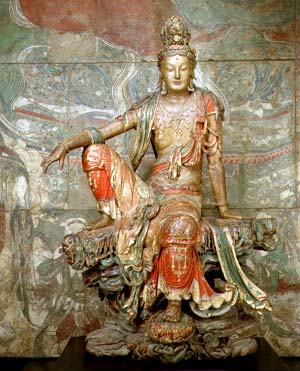

The Bodhisattva has captured the imagination of millions of people in many cultures. In India, She is known as Avalokitesvara and in Tibet as Chenrezig; both those cultures consider Her to be a masculine deity. In many other places, She is feminine: in Japan as Kannon, in China and the West, as Kuan Yin or Kuan Shih Yin.
Whether or not The Bodhisattva is perceived as a Goddess or God capable of giving and receiving favors, she is recognized by many to be a symbolic representation of our instinctive impulse to practice compassion.
Her full name, Kuan Shih Yin, means "She who hears the cries of the world," defining her as an ultimate expression of compassion. She continues to inspire people around the globe to look within and touch the wellspring of their innate compassion.
In the story of her spiritual journey, upon hearing the cries of suffering in the world, she delayed her own passage through the Gate of Ultimate Liberation and vowed to remain and assist all who suffer, so that they might accompany her when she finally passes through that gate.
The Lotus Sutra speaks of her thirty-three manifestations. Many cultures contain wonderful folk tales of her various forms and many blessings. Kuan Yin of the Moon, Kuan Yin of the Water, the playful Kuan Yin, and the Kuan Yin of the Lotus leaf are a few examples. She is often portrayed with a thousand arms, each one responding to an individual cry for help.
Blofeld, John. Bhodhisattva of Compassion: The Mystical Tradition of Kuan Yin. Boston, Shambhalla, 1977.